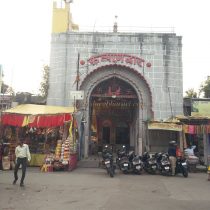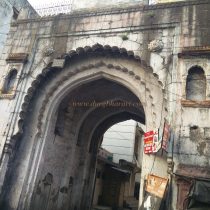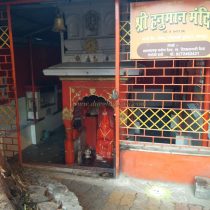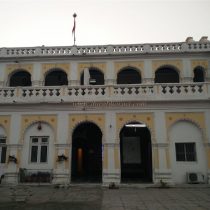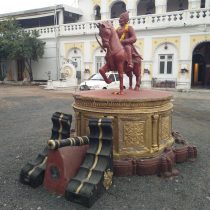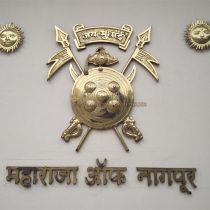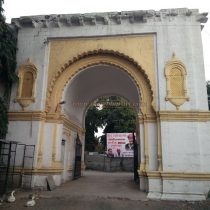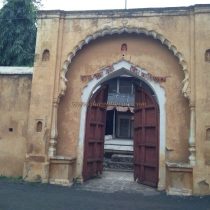NAGPUR
TYPE : GROUND FORT
DISTRICT : NAGPUR
HEIGHT : 0
GRADE : EASY
The fort of Nagpur is known as the fort of the Gond king in the palace area of Nagpur city. It would be more accurate to say that there was a fort rather than to say that there is a fort, as there are no remnants of the fort left except for one door. The Kalyaneshwar Temple and Darwaza in the palace in Old Nagpur is famous. After passing Kalyaneshwar Darwaza, there is a small alley on the right side. This alley is the main gate of the fort. It is said that the fort was once surrounded by water-filled moats and fortifications, but due to increasing urbanization, a large amount of the history of Vidarbha has been lost in this alley. One of these bastions survived until very recently, but today it is nowhere to be found. The arch of the main gate to the north of the fort still survives, with an inscription in Persian carved on the gate.
...
There is a wooden door of the palace about 200 feet. Inside the door is the ruined palace. There is a fountain made out of marble in the courtyard of the palace and a well can be seen here. This palace is the only remains of the Gond king's fort that can be seen now. While wandering around the palace area, you can see Bhosale's palace and some other old mansions and temples. Apart from this, Jumma Darwaza, Kalyan Darwaza, and two other doors can be seen in the ramparts of the gate. During the reign of Rani Durgavati in Madhya Pradesh, the kingdom of Gond at Gadha-Mandla was well expanded. After Akbar's invasion in 1564, the kingdom was divided into Chandrapur and Devgad. The Gond dynasty of Devgad was originally from Haryana or Haryagad. Devgad was chosen as the seat of the kingdom by a capable man named Jatba from this family. After the king of Gadha accepted the ruling of the Mughals, jatba also became part of the Mughal kingdom. In Akbar's time, he was the commander of 2,000 cavalries, 10,000 infantry, and 100 elephants, this is mentioned in his book Ain-E-Akbari. His own minted coins were used as currency at the time. When the borders of the state extended till Nagpur, he built a fort there and established Thane. After jatba, his son Kesarishah aka Kokshah came to the throne. In 1637, due to the non-payment of ransom by Kokshah, Shah Jahan's Sardar Khan Dauran took possession of the territory up to Nagpur. At this time, they attacked the fort of Nagpur and blew up three or four bastions of the fort. On this Kokshah made a pact by giving 175 elephants with Rs. 1.5 lakhs and saved the fort of Nagpur. Kokshah had five children. After the death of Kokshah, Mahipatshah aka Bakhtabulandshah came to power. After being dethroned by his brothers for power, he went to Aurangzeb. When Aurangzeb made it a condition to become a Muslim for help, he insisted that he would trade bread with Muslims but not their daughter. When he got his kingdom back, he accepted the names of Muslim hairdressers, but even today, the locals perform Hindu-Gond marriage ceremonies and then Muslim rituals. Bakhtabuland appointed Rajmal Kayastha as Diwan and handed over the civil affairs to Ramji Tribank. In 1702 he built a new Nagpur. During this period there were twelve villages around Nagpur known as Rajapur Barsa, Rajapur, Raipur, Hivri, Haripur, Vathode, Sakkardara, Akri, Lendhra, Futala, Gadge, Bhankheda, Sitabardi. He connected all these villages with new roads. New roads were also built in the village. Therefore, he is considered to be the creator of Nagpur. After Bakhtabulandshah, his son Chandsultan came to the throne. During this period Nagpur flourished a lot. He dug the Shukravar lake and built ramparts around the village. After the death of the Chandsultan, his illegitimate son Valish took over the kingdom. At this time, Ratan Kunwar, the wife of Chand Sultan, enlisted the help of Raghuji at Bham in Yavatmal district to bring the state under her control and Raghuji Bhosale entered the politics of Nagpur. On his return to the kingdom, Ratan Kunwar gave a share to Raghuji along with his two sons, Burhan Shah and Akbar Shah. Later due to some reasons, Burhan Shah handed over most of the kingdom to Raghuji and he stayed in the fort of Nagpur. The history of Nagpur after this is about the Bhosle family of Nagpur. In the Sakkardara area, there are neglected tombs of father and son, Bakhtabulandshah, and Chandsultan.
© Suresh Nimbalkar

